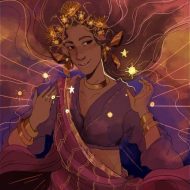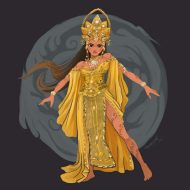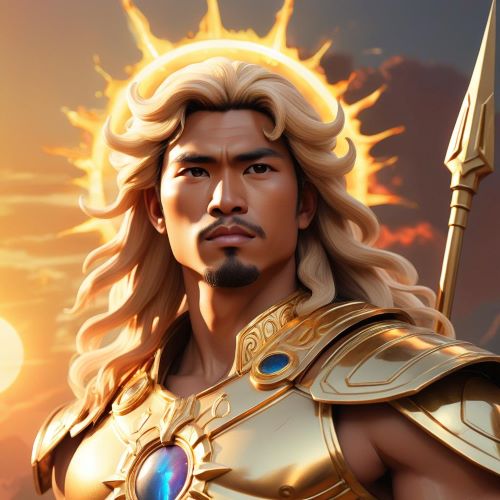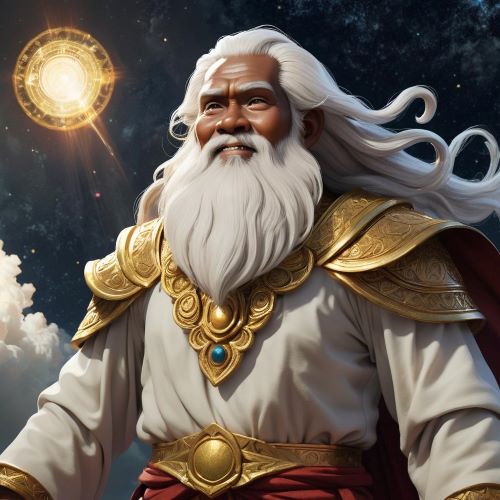Tala : The Goddess of Stars
Listen
At a glance
| Description | |
|---|---|
| Origin | Philippine Mythology |
| Classification | Demigods |
| Family Members | Bathala (Father), Mayari, Hanan (Sisters) |
| Region | Philippines |
| Associated With | Night, Stars |
Tala
Introduction
Tala, inspired by the Hindu goddess Tara, is the revered deity of the morning and evening star in Tagalog mythology. Her origins, however, exhibit regional diversity. The “Golden Tara,” a gold statue dating back to the Majapahit era, featuring the Hindu deity Tara, was discovered in 1918 in Agusan. The tale of Tala shares striking similarities with legends from cultures beyond the Philippines, including Indian tribes in Bihar, Savara, Bhuiya, as well as the Indianized Semang, a Malay tribe. Tala’s cultural significance goes beyond her celestial role; she also embodies important values and beliefs within Filipino society.
Physical Traits
One of the key attributes associated with Tala is her beauty. She is often described as a beautiful maiden, with her radiance compared to the dazzling stars themselves. This image of Tala as a paragon of beauty reflects the Filipino appreciation for aesthetics and grace.
Family
One of the most widely embraced legends surrounding Tala is the belief that she is one of Bathala’s three daughters, born to a mortal woman. Her siblings include Mayari, the moon goddess, and Hanan, the goddess of the morning. Tala is celebrated for her role in the creation of the traditional Tagalog constellations. Using luminous spheres or orbs, she guided and protected people during the night, ensuring their safe journeys. However, the perception of these orbs among the natives shifted over time due to the influence of Spanish-introduced traditions, notably the “santelmos,” which were considered deadly or misleading entities.
In another, more contemporary narrative, the sun god Arao, likely representing Apolaki, and the moon goddess Buan, presumably Mayari, had vast families of stars. However, Buan was convinced that her stars couldn’t withstand Arao’s scorching heat. In a joint decision, they opted to obliterate their stars. Arao devoured his stars, while Buan concealed hers in the clouds, allowing them to emerge occasionally. This action infuriated Arao, who relentlessly pursued Buan in an attempt to destroy her. Eclipses were explained as Arao getting dangerously close to biting her. At dawn, Buan concealed the stars, revealing them only when her eldest daughter, Tala, the evening and morning star, signaled that the sun was too distant to threaten them.
In Kapampangan mythology, a deity known as Tálâ holds a prominent position. For the Kapampangans, Tálâ is the radiant star and the figure credited with introducing wet-rice cultivation in Pampanga.
Other names
It’s worth noting that the name “Tala” is drawn from various captivating myths and signifies “bright star” in Tagalog. Furthermore, Tala’s roots can be traced back to the Hindu goddess Tara, adding an intriguing layer to her cultural and mythological significance.
Powers and Abilities
Tala’s celestial role holds profound significance. At dawn, she embarks on a celestial journey, guiding the sun across the vast sky as it commences its daily voyage. In the evening, Tala reappears, gracefully leading the sun away as it sets beyond the horizon. This dual responsibility as a guiding light not only underscores her celestial importance but also emphasizes her profound role as a guardian and mentor in the lives of the Filipino people.
Beyond her aesthetic allure, Tala epitomizes guidance and protection. Her daytime guidance of the sun and her role in the sun’s descent at sunset symbolize her function as a protector and a guiding force for those navigating life’s intricate pathways. In the rich tapestry of Filipino folklore, she is revered as a benevolent deity who diligently watches over individuals, ensuring their safety and overall well-being.
The concept of “sakuna” is intrinsically intertwined with Tala’s role as a guardian. “Sakuna” alludes to adverse events or mishaps that might befall individuals. In an effort to avert these unfavorable occurrences, people invoke Tala’s name and seek her protective embrace. This practice underscores the deep-rooted faith in the goddess’s ability to bestow blessings and shield against harm.
Tala’s influence reverberates throughout various aspects of cultural practices and traditions in the Philippines. In numerous indigenous Filipino communities, elaborate rituals and ceremonies are devoted to honoring her. These rituals encompass offerings as tokens of respect, heartfelt prayers, and graceful dances performed in her honor. Often coinciding with celestial events such as lunar eclipses or the emergence of particular stars, these ceremonies serve as a means of establishing a spiritual connection with the divine and seeking Tala’s benevolent blessings.
Modern Day Influence
One of the most prominent references to Tala in modern pop culture is the song “Tala” by Filipino singer and actress Sarah Geronimo. Released in 2015, the song became a massive hit in the Philippines and sparked a dance craze. The “Tala” dance, associated with the song, gained immense popularity, and countless individuals participated in dance challenges, further cementing the deity’s name in contemporary music and dance culture.
In Filipino television and cinema, characters and storylines often make references to Tala. Whether through subtle allusions or overt mentions, the goddess’s name serves as a cultural touchstone and a symbol of beauty and guidance. Tala’s name and the “Tala” dance have found a home on social media platforms, where users often share videos of themselves participating in the dance challenge. This has contributed to the perpetuation of her name and significance in contemporary internet culture.
Related Images
Frequently Asked Questions
What is lorem Ipsum?
I am text block. Click edit button to change this text. Lorem ipsum dolor sit amet, consectetur adipiscing elit. Ut elit tellus, luctus nec ullamcorper mattis, pulvinar dapibus leo.
What is lorem Ipsum?
I am text block. Click edit button to change this text. Lorem ipsum dolor sit amet, consectetur adipiscing elit. Ut elit tellus, luctus nec ullamcorper mattis, pulvinar dapibus leo.
What is lorem Ipsum?
I am text block. Click edit button to change this text. Lorem ipsum dolor sit amet, consectetur adipiscing elit. Ut elit tellus, luctus nec ullamcorper mattis, pulvinar dapibus leo.
What is lorem Ipsum?
I am text block. Click edit button to change this text. Lorem ipsum dolor sit amet, consectetur adipiscing elit. Ut elit tellus, luctus nec ullamcorper mattis, pulvinar dapibus leo.
What is lorem Ipsum?
I am text block. Click edit button to change this text. Lorem ipsum dolor sit amet, consectetur adipiscing elit. Ut elit tellus, luctus nec ullamcorper mattis, pulvinar dapibus leo.












